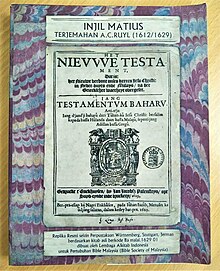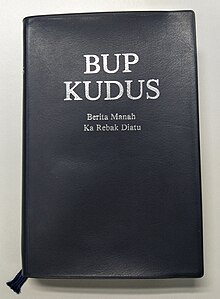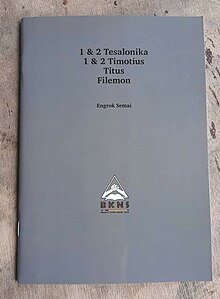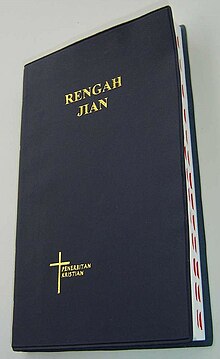
Malay is an Austronesian language that is an official language of Brunei, Malaysia, and Singapore. Indonesian, a standardized Malay-based national variety, is the official language of Indonesia and is one of working languages in East Timor. Malay is also spoken as a regional language of ethnic Malays in Indonesia and the southern part of Thailand. Altogether, it is spoken by 290 million people across Maritime Southeast Asia.

The Dayak or Dyak or Dayuh are one of the native groups of Borneo. It is a loose term for over 200 riverine and hill-dwelling ethnic groups, located principally in the central and southern interior of Borneo, each with its own dialect, customs, laws, territory, and culture, although common distinguishing traits are readily identifiable. The Dayak were animist in belief; however, since the 19th century there has been mass conversion to Christianity as well as Islam due to the spreading of Abrahamic religions.

In addition to its classical and modern literary form, Malay had various regional dialects established after the rise of the Srivijaya empire in Sumatra, Indonesia. Also, Malay spread through interethnic contact and trade across the south East Asia Archipelago as far as the Philippines. That contact resulted in a lingua franca that was called Bazaar Malay or low Malay and in Malay Melayu Pasar. It is generally believed that Bazaar Malay was a pidgin, influenced by contact among Malay, Hokkien, Portuguese, and Dutch traders.

Bidayuh is the collective name for several indigenous groups found in southern Sarawak, Malaysia and northern West Kalimantan, Indonesia, on the island of Borneo, which are broadly similar in language and culture. The name Bidayuh means 'inhabitants of land'. Originally from the western part of Borneo, the collective name Land Dayak was first used during the period of Rajah James Brooke, the White Rajah of Sarawak. At times, they were also lesser referred to as Klemantan people. They constitute one of the main indigenous groups in Sarawak and West Kalimantan and live in towns and villages around Kuching and Serian in the Malaysian state of Sarawak, while in the Indonesian province of West Kalimantan they are mainly concentrated in the northern Sanggau Regency. In Sarawak, most of Bidayuh population can be found within 40 km of the geographical area known as Greater Kuching, within the Kuching and Serian Division. They are the second-largest Dayak ethnic group in Sarawak after the Iban and one of the major Dayak tribes in West Kalimantan.

Malay was first used in the first millennia known as Old Malay, a part of the Austronesian language family. Over a period of two millennia, Malay has undergone various stages of development that derived from different layers of foreign influences through international trade, religious expansion, colonisation and developments of new socio-political trends. The oldest form of Malay is descended from the Proto-Malayo-Polynesian language spoken by the earliest Austronesian settlers in Southeast Asia. This form would later evolve into Old Malay when Indian cultures and religions began penetrating the region, most probably using the Kawi and Rencong scripts, some linguistic researchers say. Old Malay contained some terms that exist today, but are unintelligible to modern speakers, while the modern language is already largely recognisable in written Classical Malay of 1303 CE.

The Banjar or Banjarese are an Austronesian ethnic group native to the Banjar regions in the southeastern Kalimantan regions of Indonesia. Nowadays, Banjarese diaspora can be found in neighbouring Banjar regions as well; including Kotabaru Regency, the southeastern regions of Central Kalimantan, southernmost regions of East Kalimantan, and some provinces of Indonesia in general. The Banjarese diaspora community also can be found in neighbouring countries of Indonesia, such as Brunei, Malaysia, and Singapore.

The Malayic languages are a branch of the Malayo-Polynesian subgroup of the Austronesian language family. The two most prominent members of this branch are Indonesian and Malay. Indonesian is the official language of Indonesia and has evolved as a standardized form of Malay with distinct influences from local languages and historical factors. Malay, in its various forms, is recognized as a national language in Brunei, Malaysia, and Singapore. The Malayic branch also includes local languages spoken by ethnic Malays, further several languages spoken by various other ethnic groups of Sumatra, Indonesia and Borneo even as far as Urak Lawoi in the southwestern coast of Thailand.
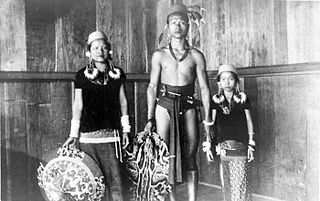
The Kenyah people are an indigenous, Austronesian-speaking people of Borneo, living in interior North and East Kalimantan, Indonesia and Sarawak, Malaysia.
The Ibanic languages are a branch of the Malayic languages indigenous to western Borneo. They are spoken by the Ibans and related groups in East Malaysia and the Indonesian province of West Kalimantan. Other Dayak languages, called Land Dayak, which are not Ibanic, are found in the northwest corner of Kalimantan, between Ibanic and non-Ibanic Malayic languages such as Kendayan and the Malay dialects of Sarawak and Pontianak.

Sacred Name Bibles are Bible translations that consistently use Hebraic forms of the God of Israel's personal name, instead of its English language translation, in both the Old and New Testaments. Some Bible versions, such as the Jerusalem Bible, employ the name Yahweh, a transliteration of the Hebrew tetragrammaton (YHWH), in the English text of the Old Testament, where traditional English versions have LORD.
The Greater North Borneo languages are a proposed subgroup of the Austronesian language family. The subgroup historically covers languages that are spoken throughout much of Borneo and Sumatra, as well as parts of Java, and Mainland Southeast Asia. The Greater North Borneo hypothesis was first proposed by Robert Blust (2010) and further elaborated by Alexander Smith. The evidence presented for this proposal are solely lexical. Despite its name, this branch has been now widespread within the Maritime Southeast Asia region.
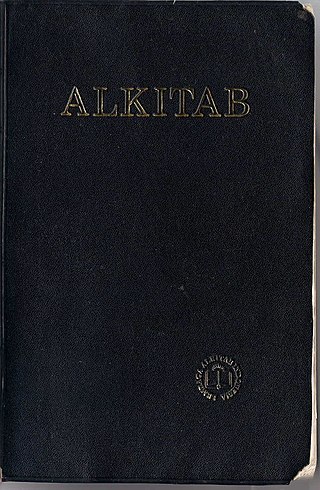
The first translation of the Bible (Alkitab) in the Indonesian language was Albert Cornelius Ruyl's translation of the book of Matthew (1629). Between then and now there have been at least 22 other translations, excluding translations to local languages of Indonesia. The most widespread translation used by Indonesian right now is Terjemahan Baru (1985), or "New Translation" published by LAI.
Kendayan, or Salako (Selako), is a Malayic Dayak language of Borneo. The exact number of speakers remains unknown, but is estimated to be around 350,000.

The Bible has been translated into multiple Philippine languages, including Filipino language, based on the Tagalog, the national language of the Philippines.
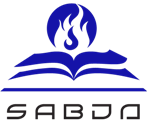
SABDA or SABDA Bible Software is an Indonesian integrated Bible study platform that's based on the Online Bible engine, with multilingual Bibles available in the program.

Pontianak Malay is a Malayic language primarily spoken by the Malay people in Pontianak and the surrounding areas in West Kalimantan, Indonesia. It is also widely spoken in neighboring regencies, including Kubu Raya and Mempawah, both of which were historically part of the now-dissolved Pontianak Regency. Pontianak Malay was also the primary language of the Pontianak Sultanate, a Malay state that once governed the area now known as Pontianak. In these regions, Pontianak Malay is not limited to being spoken exclusively by the Malay community. It functions as a lingua franca alongside standard Indonesian, enabling communication among the diverse ethnic groups in the area. However, the use of Pontianak Malay faces a slight threat as many speakers are gradually shifting to Indonesian, the national language.

Bible translations into Malay include translations of the whole or parts of the Bible into any of the levels and varieties of the Malay language. Publication of early or partial translations began as early as the seventeenth century although there is evidence that the Jesuit missionary, Francis Xavier, translated religious texts that included Bible verses into Malay as early as the sixteenth century.
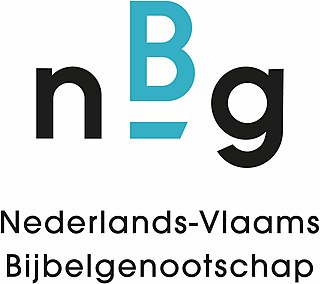
The Bible Society for the Netherlands and Flanders is a non-denominational Bible society in the Netherlands and Flanders devoted to translating, publishing, and distributing the Bible at affordable costs. The society was formed from the fusion of the Dutch Bible Society and the Flemish Bible Society in 2021 and is currently based in Haarlem.

The Bible Society of Singapore, Malaysia and Brunei was a nondenominational Christian organisation committed to translating and distributing the Bible in Singapore, Malaysia, and Brunei. It was the successor organisation to the Bible Society of Malaya, a branch of the National Bible Society of Scotland (NBSS). The Bible Society of Malaya prior to 1948 was a branch of the British and Foreign Bible Society (BFBS).

James T. Collins is an American linguist who works on comparative linguistics, lexicography, and sociolinguistics. Collins specializes primarily in Austronesian languages.

